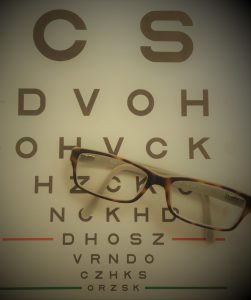Most of us are willing to go to the doctor or the dentist, which are both part of taking care of our health. However, do you go to the eye doctor? If not, you definitely should add it to your healthy lifestyle regime. Eye exams at every age and stage of life can help you keep your vision strong. August is National Eye Exam month; this is the perfect reminder to schedule a comprehensive eye exam.
The Vision Council of America reports that 12.2 million Americans require some sort of vision correction, but do not use any. Nearly 50% of parents with children under 12 have never taken their children to an eye-care professional.
Many people think their eyesight is just fine, but then they get that first pair of glasses or contact lenses and the world becomes much clearer – everything from fine print to street signs. Improving and/or maintaining your eyesight is important – about 11 million Americans over age 12 need vision correction, but that is just one of the reasons to get your eyes examined. Regular eye exams are also an important part of finding eye diseases early and preserving your vision.
Eye diseases are common and can go unnoticed for a long time. Some diseases have no symptoms at first. A comprehensive dilated eye exam by an optometrist (a medical professional with a focus on regular vision care who can prescribe eyeglasses and contacts) or ophthalmologist (a medical eye doctor with a focus on the complete eye health) is necessary to find eye diseases in the early stages when treatment to prevent vision loss is most effective. During the exam, visual acuity (sharpness), depth perception, eye alignment, and eye movement are tested. Eye drops are used to make your pupils larger so your eye doctor can see inside your eyes and check for signs of health problems.
How often should you have an eye exam?
- A child’s eyes should be checked regularly by an eye doctor or pediatrician. The U.S. Preventive Services Task Force recommends vision screening for all children at least once between age 3 and 5 years to detect amblyopia or risk factors for the disease. Amblyopia is when the vision in one of the eyes is reduced because the eye and the brain are not working together properly. The eye itself looks normal, but it is not being used normally because the brain is favoring the other eye. This condition is sometimes called lazy eye.
- People with diabetes should have a dilated eye exam every year.
- People with a family history of glaucoma should have an eye exam every year.
- Adults with good health should have an eye exam at least every 2 years.
Some people are at higher risk for glaucoma and should have a dilated eye exam every 1 to 2 years:
- African Americans, ages 40 years and older.
- Everyone older than age 60, especially Mexican Americans.
- People with a family history of glaucoma.
Early treatment is critically important to prevent some common eye diseases from causing permanent vision loss or blindness:
- Cataracts (clouding of the lens), the leading cause of vision loss in the United States.
- Diabetic retinopathy (causes damage to blood vessels in the back of the eye), the leading cause of blindness in American adults.
- Glaucoma (a group of diseases that damages the optic nerve).
- Age-related macular degeneration (gradual breakdown of light-sensitive tissue in the eye).
Other reasons to see your eye doctor: If you have any of the following eye problems, do not wait for your next appointment, schedule your eye appointment as soon as possible:
- Decreased vision
- Draining or redness of the eye
- Eye pain
- Double vision
- Diabetes
- Floaters (tiny specks that appear to float before your eyes)
- Halos around lights
- Flashes of light.
Center for Disease Control and Prevention (CDC) 10 Tips to Protect Your Vision:
- Get a regular comprehensive dilated eye exam.
- Know your family’s eye health history.
- Eat right to protect your sight. You have heard that carrots are good for your eyes. But eating a diet rich in fruits and vegetables—particularly dark leafy greens, such as spinach, kale, or collard greens—is important for keeping your eyes healthy, too.
- Maintain a healthy weight.
- Wear protective eyewear when playing sports or doing activities around the home. Protective eyewear includes safety glasses and goggles, safety shields, and eye guards specially designed to provide the correct protection.
- Be cool and wear your shades. Wear sunglasses that block out 99% to 100% of UV-A and UV-B radiation (the sun’s rays).
- Give your eyes a rest. If you spend a lot of time at the computer or focusing on any one thing, you sometimes forget to blink and your eyes can get fatigued. Try the 20-20-20 rule: Every 20 minutes, look away about 20 feet in front of you for 20 seconds. This short exercise can help reduce eyestrain.
- Clean your hands and your contact lenses properly.
- Practice workplace eye safety.
- Quit smoking or never start.
Of the estimated 61 million US adults at high risk for vision loss, only half visited an eye doctor last year. Regular eye care can have a life-changing impact on preserving the vision of millions of people. Be sure to make your eye health a priority in your life. Healthy eyes lead to better vision and an overall better quality of life. Sources: Vision Council of America https://www.thevisioncouncil.org/ Center for Disease Control and Prevention https://www.cdc.gov/
 0
0

